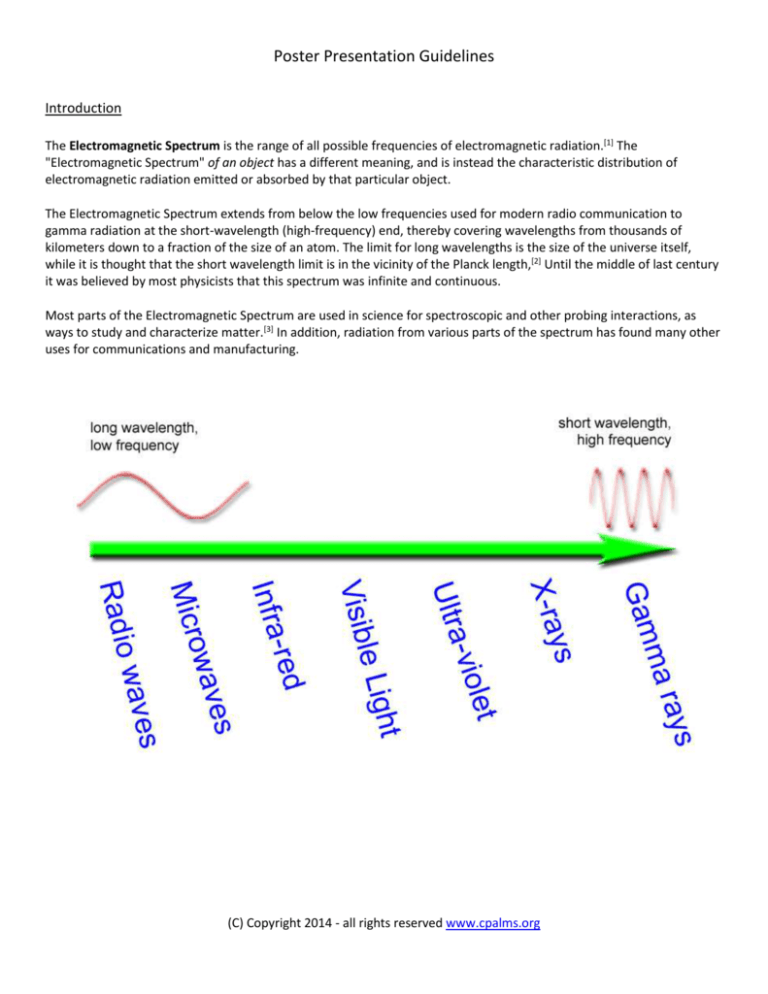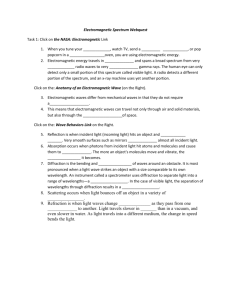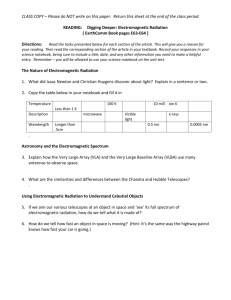
Poster Presentation Guidelines
Introduction
The Electromagnetic Spectrum is the range of all possible frequencies of electromagnetic radiation.[1] The
"Electromagnetic Spectrum" of an object has a different meaning, and is instead the characteristic distribution of
electromagnetic radiation emitted or absorbed by that particular object.
The Electromagnetic Spectrum extends from below the low frequencies used for modern radio communication to
gamma radiation at the short-wavelength (high-frequency) end, thereby covering wavelengths from thousands of
kilometers down to a fraction of the size of an atom. The limit for long wavelengths is the size of the universe itself,
while it is thought that the short wavelength limit is in the vicinity of the Planck length,[2] Until the middle of last century
it was believed by most physicists that this spectrum was infinite and continuous.
Most parts of the Electromagnetic Spectrum are used in science for spectroscopic and other probing interactions, as
ways to study and characterize matter.[3] In addition, radiation from various parts of the spectrum has found many other
uses for communications and manufacturing.
(C) Copyright 2014 - all rights reserved www.cpalms.org
Poster Presentation Guidelines
Tools and Resources
Poster Paper
Markers
Internet access- If you are a technology school, students may use personal devices to access information.
Spectrum Cards
Instructions
1. Working in groups of 3 or 4, you will be assigned a specific region of the Electromagnetic Spectrum.
2. Research your assigned area of the Electromagnetic Spectrum and create a poster. Posters must include the
following:
a. Title – Name of the region of the Electromagnetic Spectrum assigned.
b. Where is this type of radiation located on the Electromagnetic Spectrum in relation to other kinds of
radiation? What properties of the wave define why it is found within this area of the spectrum?
c. Key characteristics of your type of radiation (wavelength, frequency, key facts).
d. Pictures or drawings – any visuals pertaining you your type of radiation, these can be diagrams, pictures,
or anything that help present your radiation.
e. How is it used or found in our everyday lives or certain industries? Identify and explain at least two uses.
f. Is it harmful, helpful or both? Include evidence to support your statement.
g. You must have at least 3 references and they must be sited using the following format:
Website Title:
Article Title:
Date Accessed:
Assessment
1. Use the rubric on the last page to guide you in creating your poster, your teacher will be using this to grade
your final poster .
2. Upon completion of posters, you will complete a gallery walk in order to evaluate the work of other
students. While viewing other students’ posters, you will answer questions on each type of radiation.
References
1. "Imagine the Universe! Dictionary". NASA.
2. Bakshi, U. A. and Godse, A. P. (2009). Basic Electronics Engineering. Technical Publications. pp. 8–10. ISBN 978-81-8431-5806.
3. Jump up to: a b c d e Mehta, Akul. "Introduction to the Electromagnetic Spectrum and Spectroscopy". Pharmaxchange.info.
Retrieved 2011-11-08.
(C) Copyright 2014 - all rights reserved www.cpalms.org
Poster Presentation Guidelines
Poster Rubric
Poster Component
Points
Possible
Title – Name of the region of the Electromagnetic Spectrum assigned.
2
Where is this type of radiation located on the Electromagnetic Spectrum in relation to
other kinds of radiation? This should be clearly labeled on the spectrum.
5
What properties of the wave define why it is found within this area of the spectrum?
5
Key characteristics of your type of radiation (wavelength, frequency, key facts).
5
Pictures or drawings – any visuals pertaining you your type of radiation, these can be
diagrams, pictures, or anything that help present your radiation.
5
How is it used or found in our everyday lives or certain industries? Identify and explain at
least two uses.
5
Is it harmful, helpful or both? Include evidence to support your statement.
5
Research sources are cited properly on the back of the poster.
5
Total Score
(C) Copyright 2014 - all rights reserved www.cpalms.org
37
Points
Earned








